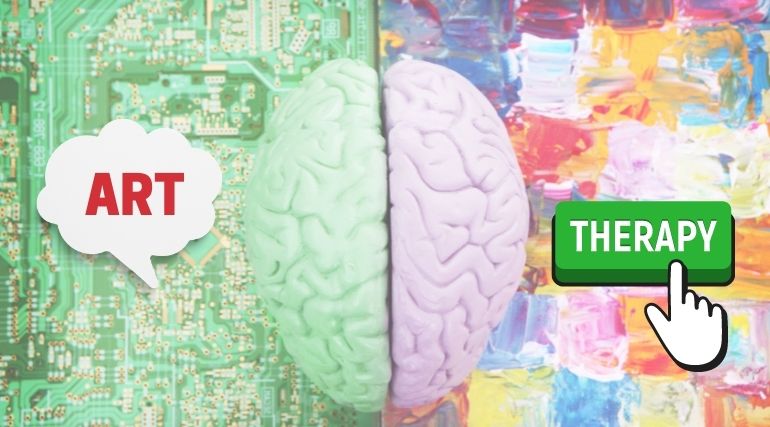How A Career In Art Therapy Can Change Your Life?
In the field of psychotherapy, art therapists typically face an uphill struggle for respect. More serious schools of therapeutic thinking generally dismiss anything having a trace of humor in it. Even the clients who may profit the most from it do not take the field seriously.
However, having fun and expressing yourself uniquely are important aspects of who your patients are. Therapies that don't use creativity and imagination are squandering vital resources. Those are the tools that art therapy takes up and paints like a Jackson Pollock painting on the canvas of therapy, uncovering important bits of thinking and experience that may help individuals get through some of their darkest periods.
You must not only complete the rigorous coursework and experience learning needed of licensed therapists or counselors, but you must also have a creative background. Even more difficult, you must learn to integrate your creativity into your therapeutic practice, as well as decode creative expression as a means of unraveling clients' core wounds.
This type of psychotherapy is used by art therapists to examine and treat individuals of all ages and with a variety of mental health and cognitive disorders. An art therapist job may be right for you if you want to assist people to attain mental health and recovery via visual self-expression.
What is Art Therapy?
Art therapy is a hybrid field that combines art and psychology to help people in treatment develop self-awareness, explore emotions, resolve unresolved emotional conflicts, improve social skills, and raise self-esteem by using the creative process, pieces of art created in therapy, and third-party artwork. Art therapy is generally used to assist people who are facing emotional or psychological difficulties in achieving personal well-being and enhanced function.
Art therapy may assist anybody seeking care from a mental health professional, regardless of past creative experience or inherent artistic aptitude.
An art therapist is a mental health professional who uses expressive therapy to help understand emotion and manage trauma. An art therapist combines psychology and the creative process of art to model healing and counseling processes. Art therapy can help manage stress, develop communication and interpersonal skills and resolve other mental health conditions.
Art therapists work in mental health clinics, hospitals, and private practices. Their patients can be of any age, and art therapists are able to treat various psychological conditions with methods of self-expression and art therapy.
Your how-to guide to pursuing a career in Art Therapy?
The Bureau of Labor Statistics reports that all therapists earn an average of $55,900 per year. Because it is a specialist industry with highly specialized training, art therapists have the opportunity to earn more.
If you wish to work as an art therapist, you need to have a background in art as well as knowledge in psychology. Here are some approaches to becoming an art therapist:
Pursue a bachelor's degree
A bachelor's degree in art education, psychology, or counseling can help you get started as an art therapist. Art therapists benefit from courses that teach visual art abilities such as sculpture, painting, and sketching since these approaches allow patients to express themselves. You can take courses in cognitive, developmental, or physiological psychology as part of your bachelor's degree program to gain a wide grasp of mental health challenges and treatment alternatives.
Obtain a master's degree
A master's degree offers additional coursework and fieldwork that prepares students for licensure in art therapy. Students get instruction in group therapy, psychological development, the creative process, art therapy evaluation, and research methodologies while pursuing a master's degree in art therapy.
Work in a clinical internship
To become a licensed art therapist, the American Art Therapy Association mandates that you complete 600 hours of clinical internship in art therapy. An art therapist watches students while they assess and treat real patients during their art therapy internship. A trained art therapist leads students through scenarios they may experience during their clinical internship. Art therapy majors are prepared to work with their own patients in the future via the use of art and psychological abilities.
Build a portfolio
An art therapy portfolio contains the student's own artwork as well as case studies from their internship. A portfolio is a great approach to show off your artistic talents and show employers that you understand the creative process and can properly interpret other people's work. It's a good idea to establish a portfolio as soon as you start attending art classes so that you have a significant body of work to show.
Earn credentials
The Art Therapy Credentials Board must certify you before you may practice as an art therapist. You can get certified after completing a master's degree and an art therapy internship. The Art Therapy Credentials Board assesses your studies and certifies that you are qualified to practice art therapy.
Best places to pursue Art Therapy
Art therapy schools assist students in developing strong core abilities that allow them to interpret art in a more personal and therapeutic way for their clients. An art therapy school may help students improve their artistic abilities as well as their capacity to comprehend and evaluate art and the creative process. If you wish to work as a professional art therapist, you must first fulfill the necessary bachelor's degree requirements before moving on to the master's degree requirements.
Georgia College & State University (Milledgeville, USA)
A Master of Arts in Art Therapy is offered by Georgia College. The unique curriculum offers prospective clinicians, therapists, and instructors a full art therapy education. Students get the skills and information necessary to work in a range of contexts. The following are examples of coursework:
Art Therapy & Counseling Practicum, Cultural and Social Diversity, Art Therapy & Counseling with Children, Art Therapy & Counseling Adolescents, Art Therapy & Counseling Adults, and Symbolism & Metaphor in AT are among the topics covered.
Art therapy professionals that work with a variety of populations benefit from the education and practical experience.
Concordia University (Montréal, Canada)
Individuals, families, and communities can benefit from art therapy at Concordia University Montréal, which provides a wide range of life-enhancing and strengthening activities. Nonverbal modalities of communication are encouraged in art-based therapeutic techniques to communicate emotional challenges and a wide range of life experiences in ways that spoken language cannot.
The MA in Creative Arts Therapies, Art Therapy program at Concordia University Montréal allows you to combine your love of art with a career in therapy. As scholars, researchers, and certified art therapists, our exceptional faculty members offer a wealth of theory and practical expertise. They will help you establish broad and profound applications of art therapy interventions, research, and clinical applications.
Take advantage of two eight-month practicums in which you will work directly with clients under the supervision of an on-site supervisor and your departmental supervisor. The Centre for the Arts in Human Development and the Art Hives network associated with Concordia University are two nearby places where you may do your practicum. Hospitals
and health care institutions, community centers, geriatric facilities, and schools are therefore options for placement.
University of Derby (United Kingdom)
The centrality of the image and the role of the imagination in art therapy are emphasized in the University of Derby's Art Therapy program. It will provide you with supervised clinical art therapy practice, as well as group work, studio practice, and a critical awareness of contemporary theoretical ideas. The Health and Care Professions Council has authorized and accredited the course, and the British Association of Art Therapists has recognized it.
The University of Derby's Art Therapy program can lead to a career in mental health, education, prisons, social services, and the voluntary sector, as well as private practice (after earning further post-training clinical experience) and, increasingly, business.
Cork Institute of Technology (Ireland)
Cork Institute of Technology's Art Therapy program seeks to provide art therapists with a variety of therapeutic skills and interventions to deal with both individual and group clients in a variety of health and community contexts.
Cork Institute of Technology's Art Therapy program is a two-year taught master's degree that provides professional training in art therapy. Students build a grasp of the ideas and methods of art therapy essential for safe therapeutic work via theoretical study, experiential learning, and clinical placement. The MA in Art Therapy is a recognized credential for practicing art therapy.
New York University (USA)
New York University is one of the most prestigious colleges for individuals interested in pursuing a career as an art therapist. NYU offers a Master of Arts in Art Therapy program that focuses on academic studies, cross-cultural competency, and evidence-based therapeutic practice.
The curriculum offers supervision that tackles current social justice concerns while also utilizing innovative teaching technologies. Moreover, the curricula seek to educate students for jobs as art therapists by preparing them in cognitive, psychomotor, and affective learning domains.
Learners complete 39 credits in core major classes, nine credits in electives, and a 12-credit internship. Master's degree candidates must also complete a thesis project in addition to the training and internship requirements.
Scholarships to apply in for Art Therapy
Art therapy is a wonderful way to escape reality while also honing one's talents and reducing stress. Painting, music, and other visual abilities are used by art therapists to assist their patients to communicate their inner turmoil. After experiencing trauma, art may be a freeing kind of inner healing.
While in college, art therapists must attend clinical and psychological sessions in order to enhance their whole personalities. The scholarships listed below provide financial assistance to undergraduate students from low-income families. These scholarships assist students in meeting their academic and social responsibilities without dropping out of school.
The Marcia Rosal Scholarship for Art Therapy
A fantastic chance for those interested in pursuing a career in the fine arts. Students from low-income families are encouraged to apply for the bursary. The award is named after a well-known individual who served as the previous Chair of the Department of Arts Education. She was also the Program Director of Florida State University's Department of Art Therapy.
Students beginning their second year of study at Florida State University are eligible for the scholarship. This scholarship will allow them to further their art expertise while also allowing them to pursue an amazing academic route at FSU.
Art Therapy Founders Scholarship
Dr. Gussie Klorer, the EU's first Director of Graduate Studies, founded this renowned prize. It offers financial help to students from low-income families. The student must write a 300-word essay about how he or she sees himself or herself as an art therapist. They should also give a full account of their financial condition, including any outstanding debts or liabilities.
The scholarship is given to students who have been authorized by the chair of the Department of Art and Design's scholarship committee. The grant covers tuition for students enrolled in the EU's MA program in art therapy.
American Art Therapy Association Scholarships
Art therapists as mental health practitioners are regulated by the American Art Therapy Association, which was founded in 1969. This foundation aims to develop mental health well-being by establishing a profession in advanced applied psychology and psychotherapy human interactions via the countless students graduating in art therapy each year.
Scholarships are available at various levels for students who have a strong academic record and work for the best in the field of art therapy. Scholarships are available to current members of this foundation's student body.
Creative Art Therapies Scholarship
The Creative Art Therapies Scholarship has been established by the Fine Arts Association for promising students from low-income families. These pupils' total family income must be at or below 200 percent of the federal poverty level. Students whose parents are in need of financial assistance, such as those who are homeless, disabled, jobless, or bankrupt, are eligible to apply.
To be eligible for the scholarship, the student must be enrolled in the FAA Institute's course and show evidence of income.
Dr. Nancy Mayer Knapp Memorial Scholarship
The Dr. Nancy Mayer Knapp memorial scholarship is given out by Emporia State University every year to meritorious art therapy students. Dr. Nancy joined the college's faculty in 1990 and was subsequently promoted to Associate professor. She also served on the board of the American Art Therapy Association. She was also a member of the Board of Directors for the Art Therapy Certification Program.
This stipend is awarded on a first-come, first-served basis to students who have chosen art therapy counseling as their major. Second, to a clinical psychology graduate student, and third, to a graduate of the Department of Psychology.
What can you do with the degree?
Those who are referred to an art therapist do not need to have any prior experience with art or be particularly skilled at it. The goal is to utilize art as a means of communication and to aid in self-awareness and growth in a secure setting.
Clients can be youngsters or adults who have:
- Behavioral and emotional problems
- Learning problems, mental illness, and speech and language challenges are all examples of learning disabilities.
- Therapy can take place in a group or one-on-one environment.
As part of a multidisciplinary team, you may collaborate with other healthcare professionals such as psychologists, speech and language therapists, social workers, and occupational therapists.
Art therapists are also known as art psychotherapists, and the Health & Care Professions Council protects both occupational names (HCPC).
Working employee
Art therapists often work full-time in clinics, hospitals, shelters, rehabilitation centers, and eldercare institutions, putting in 30 to 40 hours each week. They can also work in private practice, where they can set their own hours and decide how much work they want to do. Art therapy is a career that entails working closely with people who are experiencing mental health issues or who have cognitive limitations. Art therapists collaborate with a patient's medical team, which includes the patient's physician, other therapists, and medical assistants.
Business owner
Many students who are considering becoming an art therapist or who are just beginning their education envision themselves launching their own private practice. The "business owner" approach is essentially the one we're considering.
Having your own private practice and delivering art therapy services to your customers from your own office is part of this approach. You find your own clients, establish your own fees (*to a degree, because if you deal with insurance companies, their rates are determined for you), market yourself, and have your own office.
Freelancer
The freelancing road is a well-kept secret that few people are aware of. You basically contract with various organizations or businesses to deliver art therapy services to their clientele in this way. You work on a contract basis and are self-employed.
The following are some of the path's distinctive features:
- You are not required to find your own clientele.
- Pay is usually higher per hour than that of workers.
- Flexibility in time
- Your work has a lot of variety.
This is a very undiscovered approach that students should investigate or explore if they don't want to be tied to one location all of the time or just want more schedule and income flexibility.
Online entrepreneur
This is a rather obscure trail. Even far less than the road of the freelancer. That is due to the fact that it is so novel. It's as though it just came out of the printer. This career as an online entrepreneur entails developing online content and delivering online services in order to generate money.
The following are some of the path's distinctive advantages:
Diversified income- You can have multiple income streams. You may make money by sharing what you know online (videos, blogs, ebooks, classes, and so on) as well as by selling your services (1:1, group programs, etc)
Passive income - Many of the internet income sources are passive (meaning you may earn without "actively" working or visiting clients). This means you're not exchanging money for time.
Location freedom - Because you work entirely online, you may live a "laptop lifestyle" and work from wherever you wish. You may also become a digital nomad, traveling while simultaneously working.
No salary cap - Isn't it true that when you swap time for money, you're only limited by how much time you have on hand? And we only have so much time to work each day. As a result, if you have passive income, you may earn without having to work. You can also simply pick your own fee and develop your business to whatever size you desire, so there is no salary cap!
Helping individuals all around the globe - Working online entails assisting people all over the world. This is one of the most fascinating aspects of the route.












